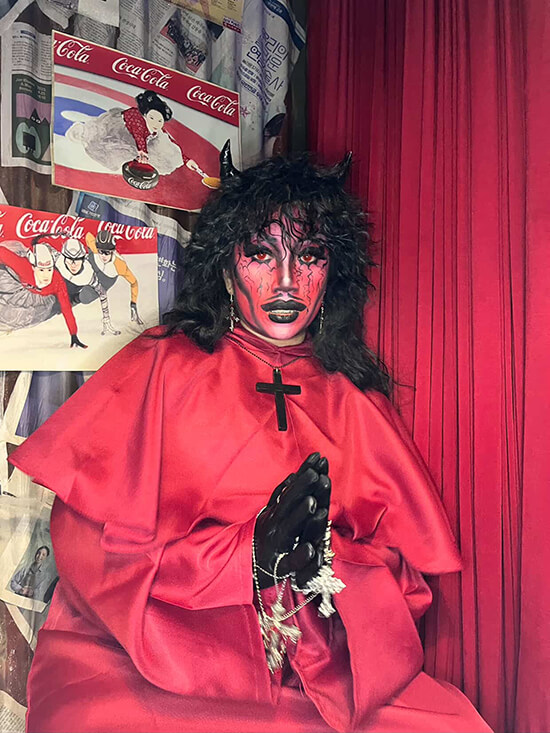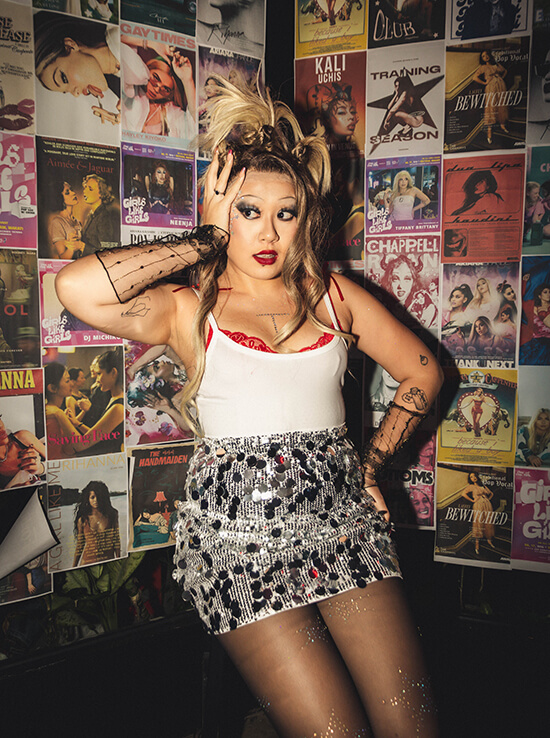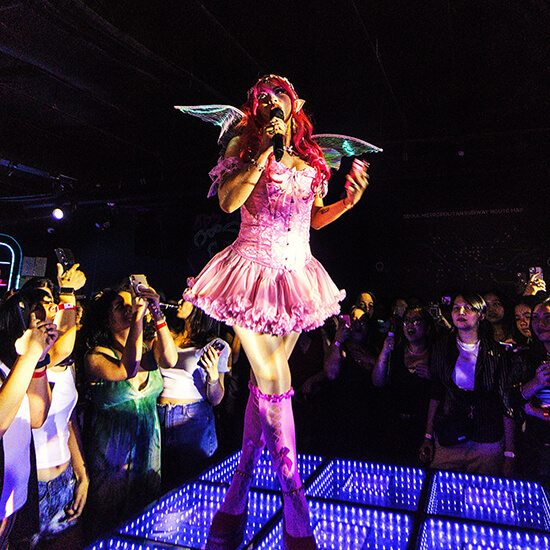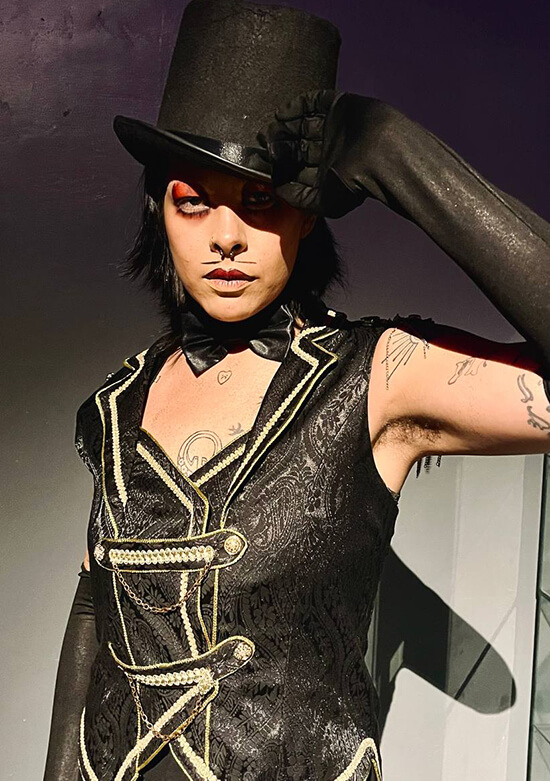The rise of sapphic drag: Meet the kings and queens
Enter the world of sapphic drag kings and queens. Beyond the makeup and the glitter, these performers are carving out space for themselves in the Philippine drag scene—one normally dominated by cis gay men.
From lesbian hyperqueens to transmasculine drag kings, these artists challenge and reimagine what it means to be a drag artist. Who gets to be in drag? How does being sapphic seep into their performances? What does it take to be seen and included as a sapphic artist?
We talk to Inah Demons, Savvy, Drew, and Tiffany Brittany, sapphic drag kings and queens using the stage to explore their identities, showcase artistry, and reclaim visibility.
Beyond the persona
Off-stage, our drag kings and queens move through their everyday lives as Marts, Hannah, Drew, and Meg. Marts transforms into the alternative drag king Inah Demons onstage, but is a full-time social media manager and graphic designer during the day. They had their first introduction to drag after a fascination with the RuPaul’s Drag Race franchise. Their inspiration for drag was specifically Drag Race’s Season 9 winner: the alternative drag queen Sasha Velour.

“Natamaan talaga ako sa message niya that literally anyone can do drag. She was a champion for the freaks, for the weirdos,” Marts shares. Soon enough, they began experimenting with drag makeup, eventually leading them to their first performance.
Drew, a drag king, writer, and burlesque and kink performer, found the same message to ring true. After a friend became a drag queen themselves, they realized how “drag was something you could do, not just watch or consume.”
From lesbian hyperqueens to transmasculine drag kings, these artists challenge and reimagine what it means to be a drag artist.
“I knew that intellectually,” she says. “But it was the first time that I knew it in my soul and actually believed it.”
Hannah, the woman behind Tiffany Brittany, can relate. Hannah works in marketing in her day-to-day life, and transforms into Tiffany Brittany, a lesbian hyperqueen, during her performances. After watching the Drag Race franchise during the pandemic, Hannah started doing drag—and eventually, it became tied to her identity. “I saw the magic behind it,” she says. “I always liked makeup and dressing up; I liked hyperfemininity in that way. I was just coming out as a lesbian and as I did drag, it allowed me to embrace the femininity in me as a lesbian.”

Hannah isn’t alone in her personal journey being tied to her drag persona. Meg, a lesbian artist who performs as Savvy, shares how being sapphic is intertwined with her drag. “My tag is literally ‘your sapphic fantasy,’ and that’s an active choice, not just for branding’s sake. Being sapphic is such a huge part of who I am, even outside of drag,” she explains. “In my drag, it bleeds into everything I do. In my song choices, it’s sapphic music. In my style, I put carabiners on, and my nails are short in the right places. It’s in my advocacy as an artist.”
'Sapphic' as an identity
What does “sapphic” really mean?

The word originally came from the ancient Greek poet Sappho, who was known for her work exploring desire and love between two women. From this history, the word “sapphic” has since evolved. Now, it’s primarily used as an expansive term that encompasses gender identity and sexual orientation. It can refer to lesbians, bisexuals, pansexuals, as well as nonbinary, trans masc, and trans femme people.
However, just this definition isn’t enough to encapsulate the entire meaning of being sapphic. When I ask our drag kings and queens their own definitions, one thing kept coming up: It’s more complicated than just romantic or sexual orientation.
“I don’t think it can simply be explained with just ‘it’s attraction to women,’” Marts says. “It comes with a lot more than just attraction—it’s defying gender norms, coinciding with being non-binary and gender non-conforming.”

Drew agrees, and their definition goes beyond identity. “It’s more than just orientation of sorts, it’s a culture,” they assert. “Obviously, the thing that connects us all is our love for and our desire for women, and the way that we love and desire women is very different from how men do it. There’s something very creative about it, especially in the sense of things I’ve created or become because of my desire for women.”
To be sapphic, Hannah reflects, is to have “a sort of understanding of each other (that other) people don’t have, and that’s what makes it really special.”
To be sapphic, then, is to belong to a world that understands instead of misconstrues; that creates space for people to let go of the need to explain instead of constantly justifying their existence. For Meg, being sapphic is both her take on reclamation and life. “It’s how I love,” she explains. “It’s how I see the world, and how I reclaim my space. With a lot of what I do, I lead with sapphic energy.”
It’s clear that being sapphic goes beyond the label. However, to be one in the drag scene comes with challenges.
Fighting for equality and visibility
Even in queer spaces, inclusion isn’t always a given.
“Lesbians and trans men in the LGBTQ+ community tend to be the most underrepresented,” Hannah says. “It’s something we have studies on and something we also experience ourselves. As a performer, because I consider myself a very sapphic drag queen, the references I make are true to my experience.”
“Sometimes, when there’s a lack of sapphic spaces, it’s hard to resonate with everyone if they don’t understand the impact of your performance. There’s confusion sometimes when you’re a woman who does drag, because the stereotype is usually that drag is just for men or gay men, but it’s really not. It’s an art form and anyone can do it.”
This lack of understanding is something Drew knows all too well: “In a way, it can be kind of lonely,” they remark. “If being sapphic is a culture, so is being a drag queen. So is being a gay man, which tends to be most drag queens. While they are sisters and we all help each other, and we have more in common than we don’t, sometimes there’s that feeling of loneliness, of knowing you can’t quite understand each other fully or connect in the way you would with fellow sapphic artists.”
Being a sapphic performer is already something to contend with—but Drew, like Marts, is also a drag king. “We also tend not to have as much visibility as drag queens. People don’t know you can be a drag king,” they explain. “It goes back to what you experience as a woman, where you think your value is tied to being pretty and being looked at. Drag can be all about glam and being beautiful, which sells seats and gets people, but when you want something different, just knowing that there’s a space for different kinds of expression can be challenging.”
Marts knows what it’s like to be overlooked as a performer or even outright sidelined and dismissed. They recall their time as a young Drag Race fan, and how it revealed these challenges before they even started. “It was during a time that a lot of people weren’t into the concept of women doing drag. Especially ‘non-professionals’ doing drag. Online, uso pa ‘yung insult na ‘bedroom queen’ noon, usually towards women who wanted to do drag.”
The delegitimization of performers who identified as queer women or who didn’t have the same access and resources didn’t end online. As a sapphic drag king, Marts started feeling the lack of inclusion and acceptance in the drag scene in real life. “You realize you’re not booked in certain shows or certain bars. You feel as if you can’t be part of the conversation because you don’t get booked as much. They just don’t do it, and they don’t tell you why, or they don’t book you at all. Is it just because I’m a sapphic drag performer, at ‘di ako magiging bet ng crowd?”
Despite this, however, they believe strongly in the art that goes into drag and are fighting back against the norm. “You should be able to do what you want to do, regardless of your gender identity or your sexual orientation,” Marts explains. “Just because you’re not this gender or sexual orientation doesn’t mean you should be excluded from the drag community.”
Meg shared the same challenges upon discovering that conditional acceptance came at a literal price, saying, “I’ve been booked, tipped, and paid less. I’ve been told that sapphic performers aren’t marketable. I’ve sat in rooms where gay men would talk about women’s bodies in degrading ways. For a long time, I stayed quiet, because I thought my silence was the cost of inclusion,” she continues. “But I did wish I spoke up early on.”
“It became painfully clear to me that I wasn’t welcome in the scene; I was just being tolerated as long as I made myself small. When we do raise the issues, we’re told to just fix it ourselves. We’re called entitled or bitter,” Meg says.
But Meg isn’t stepping back. “It really broke my heart, but it also lit a fire in me. I keep fighting, not just to be included, but to make sure no one else gets left behind. If the worst thing they can say about me is that I care too much, then f**k it, we ball.”
A final word
To wrap up the interview, I ask what their one message was to readers as a sapphic drag artist.
Drew replies, “We were taught first as women and as queer people to really diminish our own light. Learn how to listen to that persistent voice in your head that tells you when something’s wrong or when something doesn’t feel right. Do everything you can to make it clearer and sharper so that it’s easier to listen to.”
Marts shares the same sentiment, connecting it to people who may be interested in trying out drag for themselves. “For people who are hesitant to do drag, just do it. Walang pipigil sa’yo. You really never know. Kung iniisip mo na wala kang makukuhang crowd, kahit na — just do it.”
“Book sapphic drag artists,” Hannah says. “There’s something so special about each drag performer, and it’s a deeply personal art form. If you’re looking for novelty and something truly expressive and unique, the sapphic drag artists I know bring something different to the table. Plus, I want to encourage more sapphic people to do drag! It’s really fun, and you can make it your own.”
“Book us,” Meg echoes. “Pay us fairly, engage with us, advocate for us when we’re not there, and don’t tokenize us. If our presence makes you uncomfortable, ask yourself why. If inclusion feels like a threat, maybe what you were protecting was never inclusive to begin with.”
“If you love drag, support all of it. Not just what’s on the mainstream or on Drag Race. Support sapphic drag. It’s not like we’re asking for anything special, we’re just asking to exist.”
Sapphic drag is here and thriving despite the exclusion many sapphic performers face. To take the stage means more than just entertainment. For artists like Hannah, Drew, Marts and Meg, every performance is an act of reclamation, resistance and commitment. Despite being in the margins, sapphic drag continues to carve out and transform spaces of its own.


